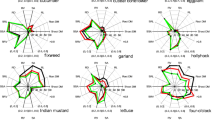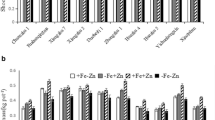Abstract
This study investigated the cadmium (Cd) accumulation and growth response to Cd stress of 18 plant species. After growth for 30 days in the sand containing 0, 2, or 10 mg Cd kg−1, seedlings were evaluated for growth parameters, specific root length, and Cd accumulation. The 18 species differ greatly in Cd accumulation and resistance to Cd stress, depending on Cd concentrations in the sand. Under high Cd condition (10 mg kg−1), the 18 species were classified into two groups: (1) Indian mustard and rapeseed having high Cd tolerance and increased accumulation capacity in shoots could be considered as Cd accumulators, and (2) the remaining 16 non-accumulators constitute a species continuum from the indicators to excluders. Shoot Cd concentration showed exponential decay relationships with biomass production, absolute growth rate, and growth ratio, indicating that biomass production negatively relates to the shoot Cd concentration in non-accumulators via dilution or concentration effect. Species with high biomass generally accumulate low Cd in the shoots and display high Cd-tolerant capacity. Indian mustard and rapeseed are promising species for long-term phytoextraction of Cd-contaminated farmlands for bioenergy production.






Similar content being viewed by others
References
Ali H, Khan E, Sajad MA (2013) Phytoremediation of heavy metals—concepts and applications. Chemosphere 91:869–881
Baker AJM (1981) Accumulators and excluders—strategies in the response of plants to heavy metals. J Plant Nutr 3:643–654
Bauddh K, Singh RP (2012) Cadmium tolerance and its phytoremediation by two oil yielding plants Ricinus communis (L.) and Brassica juncea (L.) from the contaminated soil. Int J Phytorem 14:772–785
Bhadkariya RK, Jain VK, Chak GPS, Gupta SK (2014) Remediation of cadmium by Indian mustard (Brassica juncea L.) from cadmium contaminated soil: a phytoextraction study. Int J Environ 3:229–237
Blum WH (1997) Cadmium uptake by higher plants. In: Proceedings of extended abstracts from the Fourth International Conference on the Biogeochemistry of Trace Elements, University of California, Berkeley, pp 109–110
Broadley MR, Willey NJ, Wilkins JC, Baker AJM, Mead A, White PJ (2001) Phylogenetic variation in heavy metal accumulation in angiosperms. New Phytol 152:9–27
Buendía-González L, Orozco-Villafuerte J, Cruz-Sosa F, Barrera-Díaz CE, Vernon-Carter EJ (2010) Prosopis laevigata a potential chromium (VI) and cadmium (II) hyperaccumulator desert plant. Bioresour Technol 101:5862–5867
Chunilall V, Kindness A, Jonnalagadda SB (2004) Heavy metal uptake by spinach leaves grown on contaminated soils with lead, mercury, cadmium, and nickel. J Environ Sci Health B 39:473–481
Clemens S, Aarts MGM, Thomine S, Verbruggen N (2013) Plant science: the key to preventing slow cadmium poisoning. Trends Plant Sci 18:92–99
Egan K, Hambridge T, Kayama F (2006) Cadmium-impact assessment of different maximum limits. Safety evaluation of certain food additives. WHO Food Additives Series 157–203
Eissenstat DM, Yanai RD (1997) The ecology of root lifespan. Adv Ecol Res 27:1–60
Fu X, Dou C, Chen Y, Chen X, Shi J, Yu M, Xu J (2011) Subcellular distribution and chemical forms of cadmium in Phytolacca americana L. J Hazard Mater 186:103–107
Garbisu C, Alkorta I (2001) Phytoextraction: a cost-effective plant-based technology for the removal of metals from the environment. Bioresour Technol 77:229–236
Goswami S, Das S (2015) A study on cadmium phytoremediation potential of Indian mustard, Brassica juncea. Int J Phytorem 17:583–588
Grant CA, Clarke JM, Duguid S, Chaney RL (2008) Selection and breeding of plant cultivars to minimize cadmium accumulation. Sci Total Environ 390:301–310
Gwóźdź EA, Przymusiński R, Rucińska R, Deckert J (1997) Plant cell responses to heavy metals: molecular and physiological aspects. Acta Physiol Plantarum 19:459–465
Levitt J (1972) Responses of plants to environmental stresses. Academic Press Inc., New York
Li P, Wang X, Allinson G, Li X, **ong X (2009) Risk assessment of heavy metals in soil previously irrigated with industrial wastewater in Shenyang, China. J Hazard Mater 161:516–521
Linger P, Müssig J, Fischer H, Kobert J (2002) Industrial hemp (Cannabis sativa L.) growing on heavy metal contaminated soil: fibre quality and phytoremediation potential. Ind Crop Prod 16:33–42
Liu J, Zhou Q, Wang X, Zhang Q, Sun T (2006) Potential analysis of ornamental plant resources applied to contaminated soil remediation. In: Teixeira da Silva JA (ed) Floriculture, ornamental and plant biotechnology. Global Science Books, London, pp. 245–252
Lu Z, Zhang Z, Su Y, Liu C, Shi G (2013) Cultivar variation in morphological response of peanut roots to cadmium stress and its relation to cadmium accumulation. Ecotoxicol Environ Saf 91:147–155
Lux A, Martinka M, Vaculík M, White PJ (2011) Root responses to cadmium in the rhizosphere: a review. J Exp Bot 62:21–37
Marchiol L, Assolari S, Sacco P, Zerbi G (2004) Phytoextraction of heavy metals by canola (Brassica napus) and radish (Raphanus sativus) grown on multicontaminated soil. Environ Pollut 132:21–27
McVetty PBE, Duncan RW (2015) Canola, rapeseed, and mustard: for biofuels and bioproducts. In: Cruz VMW, Dierig DA (eds) Industrial Crops. Springer, New York, pp. 133–156
Ministry of Health of the People’s Republic of China and Standardization Administration of China (2012) Maximum levels of contaminants in foods. GB2762–2012
Nawrot TS, Staessen JA, Roels HA, Munters E, Cuypers A, Richart T, Ruttens A, Smeets K, Clijsters H, Vangronsveld J (2010) Cadmium exposure in the population: from health risks to strategies of prevention. Biometals 23:769–782
Paine C, Marthews TR, Vogt DR, Purves D, Rees M, Hector A, Turnbull LA (2012) How to fit nonlinear plant growth models and calculate growth rates: an update for ecologists. Methods Ecol Evol 3:245–256
Peng K, Li X, Luo C, Shen Z (2006) Vegetation composition and heavy metal uptake by wild plants at three contaminated sites in **angxi area, China. J Environ Sci Health A 41:65–76
Raskin I, Kumar PBAN, Dushenkov S, Salt DE (1994) Bioconcentration of heavy metals by plants. Curr Opin Biotechnol 5:285–290
Raskin I, Smith RD, Salt DE (1997) Phytoremediation of metals: using plants to remove pollutants from the environment. Curr Opin Biotechnol 8:221–226
Sabreen S, Sugiyama S (2008) Trade-off between cadmium tolerance and relative growth rate in 10 grass species. Environ Exp Bot 63:327–332
Salaskar D, Shrivastava M, Kale SP (2011) Bioremediation potential of spinach (Spinacia oleracea L.) for decontamination of cadmium in soil. Curr Sci 101:1359–1363
Salt DE, Prince RC, Pickering IJ, Raskin I (1995) Mechanisms of cadmium mobility and accumulation in Indian mustard. Plant Physiol 109:1427–1433
Salt DE, Smith R, Raskin I (1998) Phytoremediation. Annu Rev Plant Biol 49:643–668
Shi G, Cai Q (2009) Cadmium tolerance and accumulation in eight potential energy crops. Biotechnol Adv 27:555–561
Shi G, Liu C, Cai Q, Liu Q, Hou C (2010) Cadmium accumulation and tolerance of two safflower cultivars in relation to photosynthesis and antioxidative enzymes. Bull Environ Contam Toxicol 85:256–263
Shi G, Liu C, Cui M, Ma Y, Cai Q (2011) Cadmium tolerance and bioaccumulation of 18 hemp accessions. Appl Biochem Biotechnol 168:163–173
Shi G, Su G, Lu Z, Liu C, Wang X (2014) Relationship between biomass, seed components and seed Cd concentration in various peanut (Arachis hypogaea L.) cultivars grown on Cd-contaminated soils. Ecotoxicol Environ Saf 110:174–181
Stingu A, Volf I, Popa VI, Gostin I (2012) New approaches concerning the utilization of natural amendments in cadmium phytoremediation. Ind Crop Prod 35:53–60
Sun Y, Zhou Q, Diao C (2008) Effects of cadmium and arsenic on growth and metal accumulation of Cd-hyperaccumulator Solanum nigrum L. Bioresour Technol 99:1103–1110
Turan M, Esringü A (2007) Phytoremediation based on canola (Brassica napus L.) and Indian mustard (Brassica juncea L.) planted on spiked soil by aliquot amount of Cd, Cu, Pb, and Zn. Plant Soil Environ 53:7–15
Uraguchi S, Fujiwara T (2012) Cadmium transport and tolerance in rice: perspectives for reducing grain cadmium accumulation. Rice 5:1–8
Wang S, Liu J (2014) The effectiveness and risk comparison of EDTA with EGTA in enhancing Cd phytoextraction by Mirabilis jalapa L. Environ Monit Assess 186:751–759
Wang J, Fang W, Yang Z, Yuan J, Zhu Y, Yu H (2007) Inter- and intraspecific variations of cadmium accumulation of 13 leafy vegetable species in a greenhouse experiment. J Agric Food Chem 55:9118–9123
Wilkes MA, Takei I, Caldwell RA, Trethowan RM (2013) The effect of genotype and environment on biodiesel quality prepared from Indian mustard (Brassica juncea) grown in Australia. Ind Crop Prod 48:124–132
**a S, Wang X, Su G, Shi G (2015) Effects of drought on cadmium accumulation in peanuts grown in a contaminated calcareous soil. Environ Sci Pollut Res 22:18707–18717
**n J, Huang B, Liu A, Zhou W, Liao K (2013) Identification of hot pepper cultivars containing low Cd levels after growing on contaminated soil: uptake and redistribution to the edible plant parts. Plant Soil 373:415–425
Yang Y, Zhang FS, Li HF, Jiang RF (2009) Accumulation of cadmium in the edible parts of six vegetable species grown in Cd-contaminated soils. J Environ Manag 90:1117–1122
Zhu Y, Yu H, Wang J, Fang W, Yuan J, Yang Z (2007) Heavy metal accumulations of 24 asparagus bean cultivars grown in soil contaminated with Cd alone and with multiple metals (Cd, Pb, and Zn. J Agric Food Chem 55:1045–1052
Acknowledgments
Financial support from the National Natural Science Foundation of China (No. 31370515) is gratefully acknowledged.
Author information
Authors and Affiliations
Corresponding author
Ethics declarations
Ethical statement
The authors declare no ethical issues for this manuscript.
Additional information
Responsible editor: Elena Maestri
Rights and permissions
About this article
Cite this article
Shi, G., **a, S., Liu, C. et al. Cadmium accumulation and growth response to cadmium stress of eighteen plant species. Environ Sci Pollut Res 23, 23071–23080 (2016). https://doi.org/10.1007/s11356-016-7545-9
Received:
Accepted:
Published:
Issue Date:
DOI: https://doi.org/10.1007/s11356-016-7545-9




